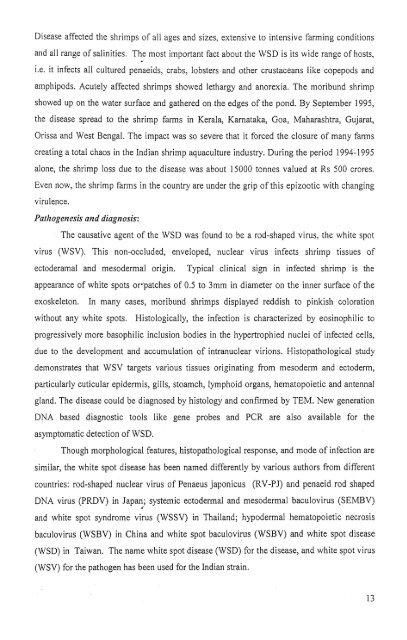, Diagnosis an-&& of Shrimp Diseases - Central Institute of ...
, Diagnosis an-&& of Shrimp Diseases - Central Institute of ...
, Diagnosis an-&& of Shrimp Diseases - Central Institute of ...
- No tags were found...
You also want an ePaper? Increase the reach of your titles
YUMPU automatically turns print PDFs into web optimized ePapers that Google loves.
Disease affected the shrimps <strong>of</strong> all ages <strong>an</strong>d sizes, extensive to intensive farming conditions<strong>an</strong>d all r<strong>an</strong>ge <strong>of</strong> salinities. 'The most i~nport<strong>an</strong>t fact about the WSD is its wide r<strong>an</strong>ge <strong>of</strong> hosts,i.e. it infects all cultured penaeids, crabs, lobsters <strong>an</strong>d other crustace<strong>an</strong>s like copepods <strong>an</strong>damphipods. Acutely affected shrimps showed lethargy <strong>an</strong>d <strong>an</strong>orexia. The moribund shrimpshowed up on the water surface <strong>an</strong>d gathered on the edges <strong>of</strong> the pond. By September 1995,the disease spread to the shrimp farms in Kerala, Karnataka, Goa, Maharashtra, Gujarat,Orissa <strong>an</strong>d West Bengal. The impact was so severe that it forced the closure <strong>of</strong> m<strong>an</strong>y farmscreating a total chaos in the Indi<strong>an</strong> shrimp aquaculture industry. During the period 1994-1995alone, the shrimp loss due to the disease was about 15000 tonnes valued at Ks 500 crores.Even now, the shrimp farnls in the country are under the grip <strong>of</strong> this epizootic with ch<strong>an</strong>gingvirulence.Patitogenesis <strong>an</strong>d diagrzosis:The causative agent <strong>of</strong> the WSD was found to be a rod-shaped virus, the white spotvirus (WSV). This non-occluded, enveloped, nuclear virus infects shrimp tissues <strong>of</strong>ectoderamal <strong>an</strong>d mesodermal origin.Typical clinical sign in infected shrimp is theappear<strong>an</strong>ce <strong>of</strong> white spots or0patches <strong>of</strong> 0.5 to 3mm in diameter on the inner surface <strong>of</strong> theexoslteleton.In m<strong>an</strong>y cases, moribund shrimps displayed reddish to pinkish colorationwitliout <strong>an</strong>y white spots. Histologically, the infection is characterized by eosinophilic toprogressively more basophilic inclusion bodies in the hypertrophied nuclei <strong>of</strong> infected cells,due to the development <strong>an</strong>d accumulation <strong>of</strong> intr<strong>an</strong>uclear virions. Histopathological studydemonstrates that WSV targets various tissues originating from mesoderin <strong>an</strong>d ectoder~n,particularly cuticular epidermis, gills, stoamch, lymphoid org<strong>an</strong>s, he~natopoietic <strong>an</strong>d <strong>an</strong>tenna1gl<strong>an</strong>d. The disease could be diagnosed by histology <strong>an</strong>d confirmed by TEM. New generationDNA based diagnostic tools like gene probes <strong>an</strong>d PCR are also available for theasymptomatic detection <strong>of</strong> WSD.Though morphological features, histopathological response, <strong>an</strong>d mode <strong>of</strong> infection aresimilar, the white spot disease has been named differently by various authors from differentcountries: rod-shaped nuclear virus <strong>of</strong> Penaeus japonicus (RV-PJ) <strong>an</strong>d penaeid rod shapedDNA virus (PRDV) in Jap<strong>an</strong>; systemic ectodermal <strong>an</strong>d mesodermal baculovirus (SEMBV)<strong>an</strong>d white spot syndrome virus (WSSV) in Thail<strong>an</strong>d; hypodermal hematopoietic necrosisbaculovirus (WSBV) in China <strong>an</strong>d white spot baculovirus (WSBV) <strong>an</strong>d white spot disease(WSD) in Taiw<strong>an</strong>. The name white spot disease (WSD) for the disease, <strong>an</strong>d white spot virus(WSV) for the pathogen has been used for the Indi<strong>an</strong> strain.
















